£0.00
0A guide to buying BIL Castors and Wheels
When it comes to choosing wheels and castors, the sheer volume available can be overwhelming. Where do you start? Does it really matter what material my wheel or castor is made from? What’s the difference between polypropylene and polyurethane wheels? Do I need cast iron or steel wheels? What is a jacking castor? What is a heavy duty castor and do I need them?
This guide aims to explain the main things to consider when selecting BIL castors and wheels and will help you to make the correct choice to suit your specific application. But if after all this you are still not sure what you really need, then please just call us on 01249 822222, use our friendly online chat option or email sales@bilgroup.co.uk. However you get in touch, we’ll be delighted to assist you.
This wheels and castors selection guide is divided into the following sections:
- What are castors and wheels?
- Where are castors and wheels typically used?
- Why use castors and wheels?
- Choosing which castors and wheels you need
- BIL castors and wheels guide
- Chemical resistance chart
1. What are castors and wheels?
Castors and wheels can be used on all kinds of things to make them easier to move around and transport. For instance you will see castors and wheels used on gates, trolleys, street sweepers, theatrical sets, industrial machinery, on amusement park rides, bakeries, kitchens, clean rooms, stables and greenhouses, on pavements, public roads, airports … the potential uses are endless.
Wheels spin on an axle and usually only allow movement laterally. However if that is not what you want, fixing swivel castors will allow you to move the product in any direction. There are many types of wheel options available in a range of sizes, materials and load bearing capacities which make them suited to multiple different uses.
We have put a Wheel Guide at the end of this document to help narrow down what type of wheel you might need.
Castors contain a wheel and an assembly unit so that they can be attached to the product that you want to move. There are two main types of castors:
i) Single bolthole castors These are limited to loads of up to 500kg having a fastener through the centre of the swivel head often in the form of a thread, bolt or expander. This type of castor comes in a choice of Swivel, Swivel Braked & Fixed*
(*only in the BIL BZRA & BZM ranges )
ii) Plate castors – typically have a common fixing – a flat bracket normally with 4 mounting holes – to allow the load to be spread. These castors can be:
- Fixed castors (rigid) – only move in straight lines and can’t be steered
- Swivel castors – can rotate 360⁰, thus moving in any direction and so are ideal when equipment needs to be manoeuvred around corners or in tight spaces.
- Swivel & braked (locking) castors – as above but fitted with a brake.
Brakes or locks can be fitted to immobilise the wheels when necessary.
All types of castors are available in a variety of materials including zinc plated / stainless steel and varying load bearings, that are suited to different uses and environments (See our Castors Guide at the end of this document.)
2. Where are castors and wheels used?
Castors and wheels can be used in any environment where apparatus or equipment needs to be mobile. This can include:
- offices
- homes – particularly for heavy furniture such as pianos and beds
- catering – food and beverage industry
- motoring and aerospace industries
- warehouses, manufacturing, distribution and logistics centres
- hospitals, labs and the pharmaceutical industry
- retail and furniture industries
- mailrooms, educational institutions
- sports centres and garden centres
- theatre, television and film making industries
As you probably realise this isn’t a complete list by any means!
3. Why use castors and wheels?
Quite simply because they make it easier to move equipment both safely and efficiently, in any environment or workplace. Heavy loads become more manageable and can be moved more quickly, under control, making the task easier and safer, while also increasing productivity and ultimately saving time and costs.
4. Choosing which castors and wheels you need
There are many things to consider when choosing your castors and wheels.
Firstly, think about what you intend to use them for; what equipment you will be moving with them? How often they will be used? How far you will be moving your equipment? How much space do you have for movement – is it a tight confined space?
Then there are further considerations:
- Do you need swivel or fixed castors? Or braked
- How you will attach your castors?
- What sort of weight will you be moving?
- Where will they be used?
- What environment will the castors be used in?
- What surface will the castors be used on?
- Will they be used in high or low temperatures?
- Will they be used where there are chemicals?
- Do you need to consider anti-static castors?
- Are these castors being towed and at what speed?
The key point here is to really consider carefully what job you need your wheels and castors to do and where they will be doing it.
Swivel, Fixed or Braked castors?
Swivel castors allow movement in any direction and so make it easier to manoeuvre equipment and goods around corners and in areas where there is not much space.
Fixed castors allow movement laterally – backwards and forwards only.
Brakes can be fitted to swivel castors which can stop movement and the swivel.
Mounting Options – how the castors attach to your equipment
If you are replacing existing castors, you will be able to tell whether it is a plate or single bolt hole mounting that you require. In either case, you will need to make sure that you also know the load capacity required (weight of the equipment).
For a single bolt hole mounting These are limited to loads of up to 500kg having a fastener through the centre of the swivel head, these come in a choice of Swivel, Swivel Braked & Fixed*
(*only in the BIL BZRA & BZM ranges.)
For a plate mounting, you will need to measure its length and width, the number of holes and the spacing between these. As mentioned above there are some industry standard sizes to look out for. Plate mountings, tend to be more robust and are usually the ideal choice if there is room for them to be attached. There are a range of sizes available to give more stability, take greater loads and these can be either fixed, swivel or braked and with swivel options you can either consider the use of a directional lock
For new applications – where you don’t have an existing castor or wheel mounting to examine – the same information and measurements (as described above) will all need to be taken into consideration. Don’t forget to consider the load weighting required.
See the section below for more information on this.
Load – the weight to be moved
Castors have varying load ratings depending on their type and the material they are made from. Each castor is designed to support a maximum load weight and it is vital to stay within this maximum limit for safety reasons and to avoid damage to the castor or your equipment.
Be aware that the condition of the surface on which you will be using your castors and wheels must also be considered. A badly cracked surface or one with numerous uneven joints or gullies will likely add extra loading onto individual castors. On an uneven surface some of the castors may lose contact with the floor meaning extra weight will fall on the other castors at that time. If this is the case in your scenario you must factor that sudden extra loading into your calculations.
Multiple Configurations – with load calculations
You don’t have to use the same castors throughout. In some cases it’s beneficial to use a mixture of castor configurations to get the ideal solution for your application and environment.
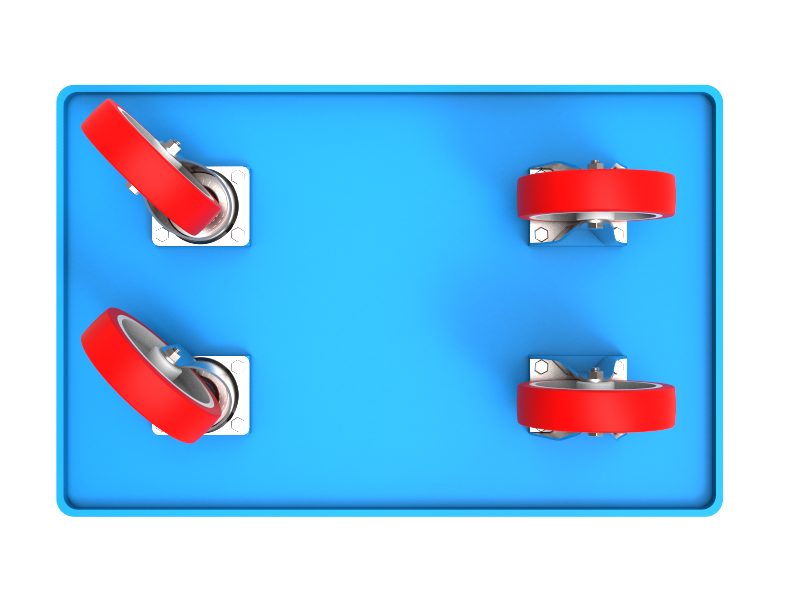
Two swivel + two fixed – this offers the safest handling and load control with good steering on straight runs and cambers. When moving, the two fixed castors should lead with the swivel castors at the back for easier manoeuvrability. This configuration works for most loads. Each castor load capacity should be calculated to be at least 33% of total load as when moving one or other of the castors may lose contact on uneven floors thereby putting its load onto the remaining castors.
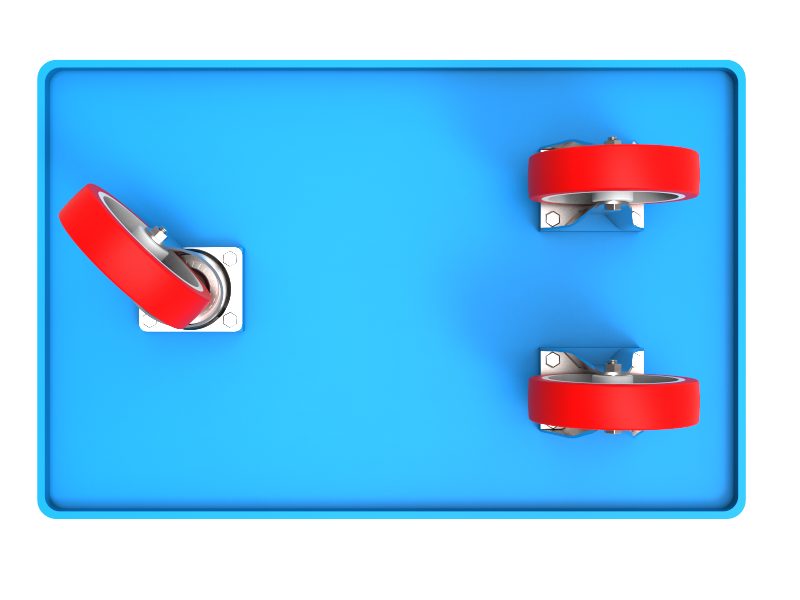
One swivel & two fixed – this will allow easy manoeuvrability but is only recommended for light loads. To ensure safe handling (avoiding tipping issues) loads must he distributed evenly. For this configuration, calculate the castor load capacity to b e a minimum of 40% of the total load weight.
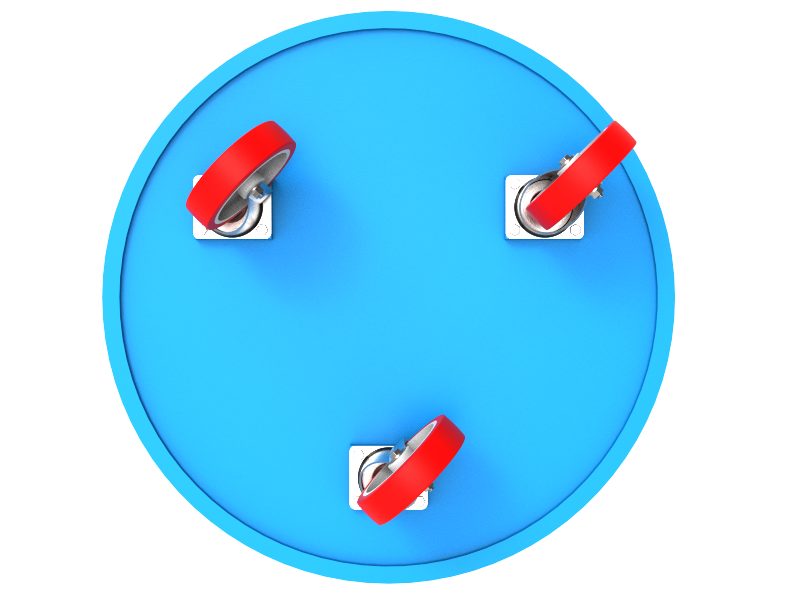
Three swivel – this will allow maximum manoeuvrability but it will be difficult to control on straight runs, and sloping or uneven surfaces. This set up is advised only for small trolleys with light loads. For this configuration calculate castor load capacity to be a minimum of 40% of the total load weight.
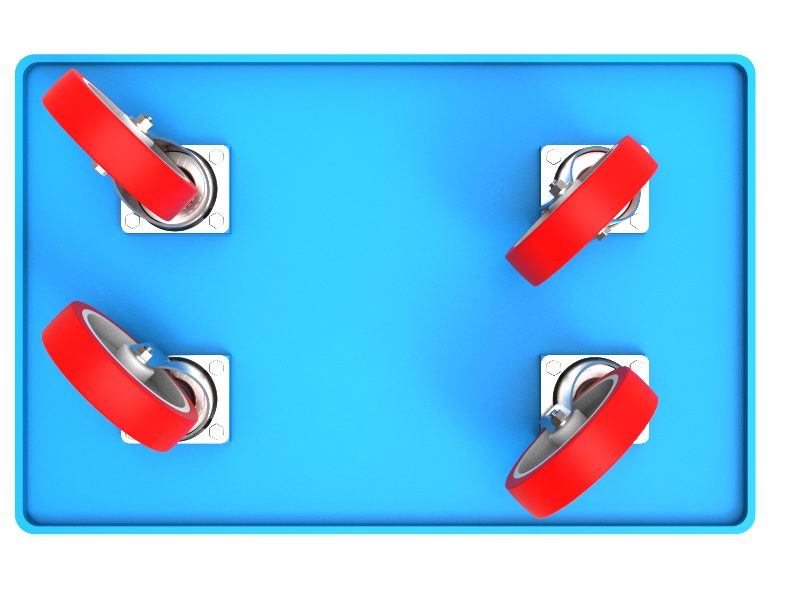
Four swivel – this will give you maximum manoeuvrability ideal for smaller spaces. But it will be harder to control on longer straight runs, or sloping and uneven surfaces. This will be especially noticeable with heavier loads. This can be addressed by using castors with directional locks. Each castor load capacity should be calculated to be at least 33% of total load as, when moving one or other castors may lose contact on uneven floors putting its load onto the remaining castors.
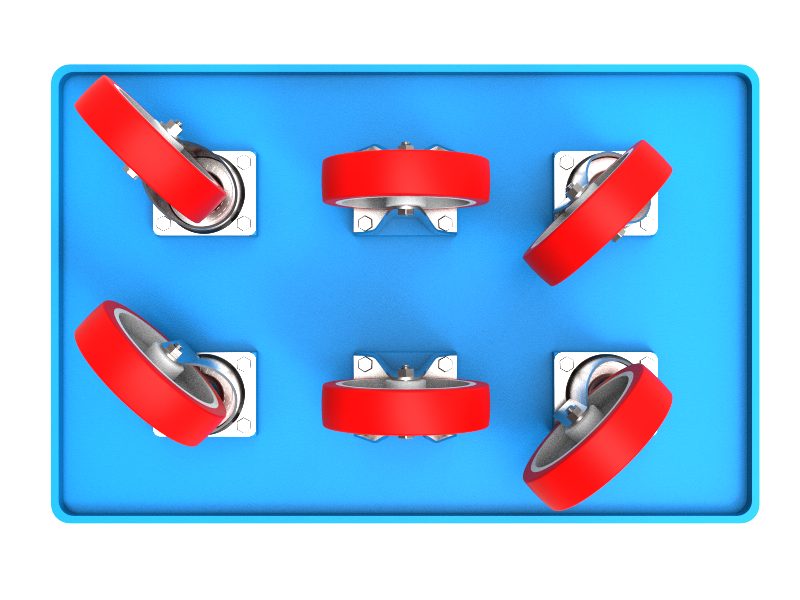
Four swivel & two fixed, centrally pivoting – usually used on long trolleys to optimise control and manoeuvrability. The two central fixed castors are usually one size larger or the same size as the swivel castors and fitted with 25mm packing under the top plate. Castor capacity for the fixed castors should be at least 50% of total gross load. Swivel castor loads will vary.
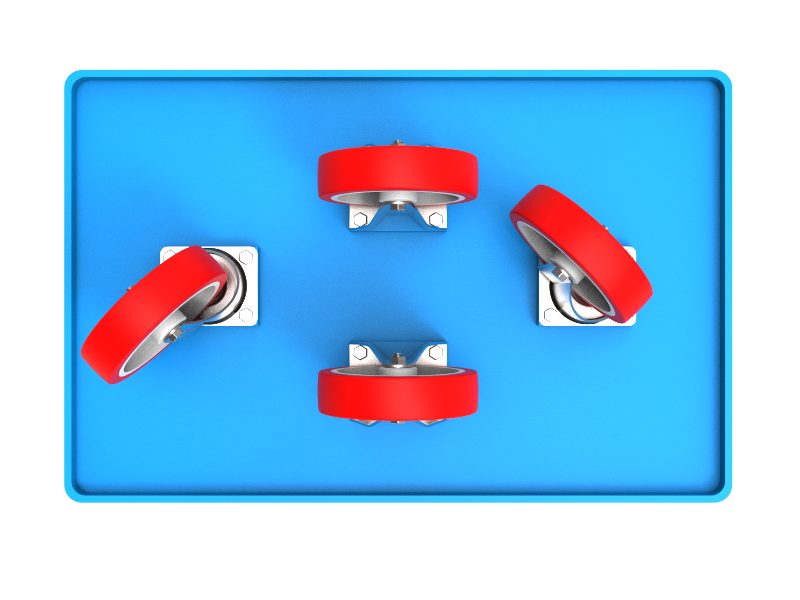
Two swivel & two fixed, centrally pivoting – similar to the above but less stable if the load is not evenly distributed. The two central fixed castors are usually the same size as the swivel or one size larger and fitted with a 25mm packing under the top plate. Castor capacity for the fixed castors should be at least 50% of total gross load.
Swivel castor loads will vary. If you would like expert advice on the most appropriate configurations for your requirements please call us.
What environment will the castors or wheels be used in?
The style and material used to manufacture the castors and wheels makes them suitable for use in different conditions. However, some materials are more effective than others on given surfaces.
Surface – what type of flooring will the castors be used on?
Are your castors going to be used indoors or outside? Will they be used on rough, smooth, hard or soft surfaces? Is the surface likely to be wet when they are used?
Hard wheel castors such as nylon and cast iron are usually better suited for smooth or soft surfaces but if the surface is likely to be damaged by the castors rolling on it then it is better to choose rubber or elasticated rubber wheels. Polyurethane wheel castors offer a greater load capacity than rubber whilst still protecting more delicate floors.
Softer wheeled castors generally perform better on hard, rough or uneven surfaces. They help cushion the load and can protect fragile product from unwanted damage. This in turn could also improve the lifespan of the actual unit itself.
For equipment that carries heavy loads, the added durability of fabricated castors is recommended. Fabricated castors from BIL Castors will take a load of 400kg up to a massive 11,500kg. Pressed Steel Castors can take up to 1,000kgs.
For comparisons and guidance see the wheels & castors guide below and don’t forget you could always contact us directly to discuss your requirements at any time.
Working in high temperatures
The different materials that castors are made from vary in their temperature resistance. If your castors are going to be used in high-temperature environments such as bakeries, ovens, powder coating environments or autoclaves, you will need specialist high temperature pressed steel and fabricated castors with high temperature wheels.
View our bakery case study to learn more and view our high temperature castors here.
Exposure to chemicals
Operating in environments where chemicals are present can seriously damage your wheels and castors if you haven’t selected the right compounds. If your castor wheels are going to be used in an environment where there are acids, oils or other corrosive chemicals then avoid rubber castor wheels (which can be damaged by exposure to these substances) and opt for polyurethane or pressed steel.
For more detailed information and to see how different castor types are rated view our Castors and Wheels Chemical Resistance Guide here.
All of the BIL Castors and Wheels ranges are provided with an indication of their resistance to commonly encountered chemicals. They are rated from A (high resistance) to F (low resistance) for nearly 30 different chemicals and corrosive substances found in many industrial and commercial environments.
The rating given is based on a prolonged immersion in the chemical, for example if this is constantly present on the floor or dripping from the load. Splashes or short exposures of the chemical or substance may well extend the life beyond the indicated level in the table. The rating is also for the whole unit and therefore consideration must be given to the wheel itself and not just the tyre. The lifespan will be affected by how much of the wheel comes into contact with the damaging substance.
You will clearly see that some wheels/tyres are excellent at coping with certain chemicals and substances but totally unsuitable in other environments. For example, solid nylon or cast iron wheels offer superior resistance to mineral and plant oil based chemicals but perform poorly when exposed to acids. Wheels with rubber or polyurethane tyres generally perform less well with most chemicals but this has to be weighed against other factors such as noise and grip, particularly on equipment that may need to be towed.
Antistatic and electrically conductive castor wheels
Anti-static and electrically conductive castors are ideal in environments where you want to avoid the build-up of static such as clean rooms, hospitals, pharmacies, chemical industries and labs. These castors will protect against the electrostatic discharge which can be generated when the equipment is manoeuvred. The conductive materials used in the construction of the castors allow the charge to go to ground more easily and so avoid damage to sensitive equipment.
View our Anti-static and Electically Conductive wheels.
Wheel size
If you are going to be using your castors frequently, then you need them to be easy to roll. Bigger wheels will roll more easily than smaller wheels. Look for castor wheels with low roll resistance.
5. BIL Castors & Wheels Guide
| Wheel type | Features | Recommended uses |
|---|---|---|
| Polypropylene Wheels and Nylon Wheels | – Hard tread – Low rolling resistance – Lightweight – Low wear – Low cost | – Hard or soft flooring |
| Standard rubber wheels | – Soft tread – Lightweight – Non marking – grey tyres – Low noise – Good grip and control | – Ideal for hard surfaces – Warehouses |
| Elastic rubber wheels | – Extra soft tread – High elasticity – Non marking – Low noise – Good grip and control – Smooth ride – High load capacity | – Ideal for hard surfaces – Warehouses |
| Polyurethane wheels | – Good appearance – Good grip & control – Low noise – Heavy duty & long life – Ideal for hard surfaces | – Picking trolleys – Warehouse trolleys – Dollies – Manual handling equipment |
| High temperature wheels | – Operate up to 4000C | – Bakeries – Powder coating – Autoclaves – Paint ovens |
| Cast iron and Steel wheels | – Heavy and extra heavy duty | – High temperature environments – Foundries – Rail and track wheels – Bakeries – Powder coating |
| Anti-static and Electrically conductive wheels | – Wheel diameter up to 200mm – Conductivity resistance R≤ 50 Mega Ohm – Load ranges up to 500kg per wheel | – Medical spaces – Pharmaceutical spaces – Health and safety equipment – Clean rooms – Labs |
| Pneumatic Wheels and Puncture proof wheels | – Wheel diameter from 200 mm up to 400 mm – Plain, roller and ball bearing options – Load ranges from 75kg up to 350kg per wheel | – Sports equipment – Flatbed trucks & trolleys – Fruit picking trolleys – Garden centres – Outdoor equipment |
| Type of castor | Recommended uses (not an exhaustive list) | Features |
|---|---|---|
| Light duty pressed steel | – For light duty and institutional use – Display equipment – Hospitality equipment – Mailrooms – Pharmaceuticals – Educational establishments | – Swivel, swivel with brake and fixed options – Available for top plate or single bolt hole fixing, with 5 different castor wheel options – Wheel diameters from 35mm to 150mm – Load ranges from 25kg up to 200kg per caster |
| Medium Duty Pressed Steel castors and Heavy Duty Pressed Steel Castors | – Picking trolleys – Warehouse trolleys – Dollies – Manual handling equipment | – For loads from 50kg up to 1000kg per castor – Swivel, fixed or swivel with lockable brakes – 10 different wheel options – Wheel diameters from 50mm to 200mm – Top plate or single bolt hole fixing |
| Medium / heavy Stainless Steel | – Medical – Pharmaceuticals – Food / catering – Wet environments | – For loads 50kg up to 500kg per castor – Swivel, fixed or swivel with lockable brakes – 10 different wheel options – Wheel diameters from 50mm to 200mm – Top plate or single bolt hole fixing |
| High temperature pressed steel and fabricated | – Bakeries – Power coating – Autoclaves – Paint ovens | – Top plate or single bolt hole fixing – 9 different wheel options – Wheel diameters from 80mm to 200mm – Temperature ranges from -40° up to +400° – Load ranges 150kg to 700kg per castor |
| Medium/Heavy duty fabricated | – Manual and towing applications – Stillages – Lineside trolleys – Tipping skips – Cradles and bogies – Tooling and jigs | – Stronger than pressed steel – Fixed, swivel, swivel with brake wheel options – Top plate only fixing – Loads from 180kg to 11,500kg per castor – Wheel diameters 70mm to 400mm |
| Pneumatic and puncture proof pressed steel & fabricated castors | – Use on softer or rougher terrains – Sports equipment – Flat bed trolleys & trucks – Fruit picking trolleys – Garden centres – Outdoor equipment | – Multiple castor options – but top plate fixing only – Choice of castor heights & treads – Fixed or swivel, with/without brakes – Wheel diameters from 200mm to 260mm – Load capacity from 70kg to 270kg per castor |
| Low, Medium and Heavy Duty Jacking Castors | – Staging – Adjustable trolleys – Gantries – Tooling | – Jacking castors safely raise and move heavy objects in any direction – Bar or crank handle operation with either swivel or swivel & brake castors – 5 different wheel options are available – Wheel diameters from 75mm to 300mm – Load ranges from 140kg up to 2800kg per castor |
| Gate Castors | – Gardens – Paddocks – Driveways -Farms – Business premises – Commercial & industrial sites | – Easy opening/closing of gates – Load capacity to 75kg per castor – Spring-loaded to absorb shocks from uneven ground – Fixed or swivel wheels 100mm diameter (use fixed for a wide, single gate, use swivel on shorter widths/distances) – Orientation of the fixed castor easily adjusted. |
| Scenery skates and the Ezeelift systems | – Opera / ballet – Theatres – Concert venues – Television studios – Museums – Film locations | – Safely & easily move heavy scenery, props etc. – Top plate or stem fixing with 4 different wheel options – Wheel diameters 35mm to 125mm – Load capacity from 50kg to 1000kg per castor |
6. Chemical Resistance Chart
Wheels and tyres when fitted directly to the unit such as a trolley or to a castor can have a pretty hard life and are often attacked by numerous chemicals in the workplace. Operating in environments
It is vital therefore to choose a wheel and tyre that can withstand coming into contact with a wide variety of harmful substances.
Fortunately BIL Castors & Wheels have made this task a lot easier, and all of our wheel & tyre combinations are provided with an indication of their resistance to commonly encountered chemicals. These are shown in the table below where we have rated the resistance from A (high resistance) to F (low resistance) for nearly 30 chemicals and corrosive substances found in many industrial and commercial environments.
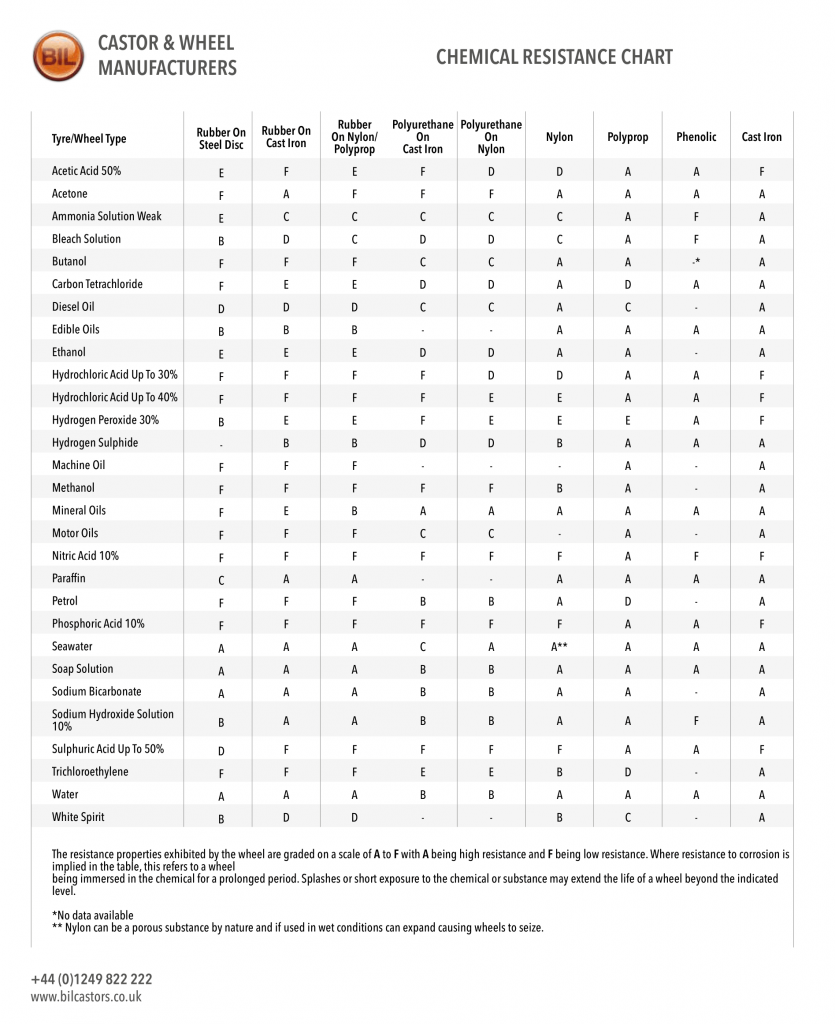
We hope that you found this Castors and Wheels Buyers Guide useful but if you are still not sure what castors or wheels you need to meet your requirements, then please just contact us directly – we’re here to help.
You can call us on 01249 822222, use our friendly online chat option or just email sales@bilgroup.co.uk.
However you get in touch we’d be delighted to hear from you.
